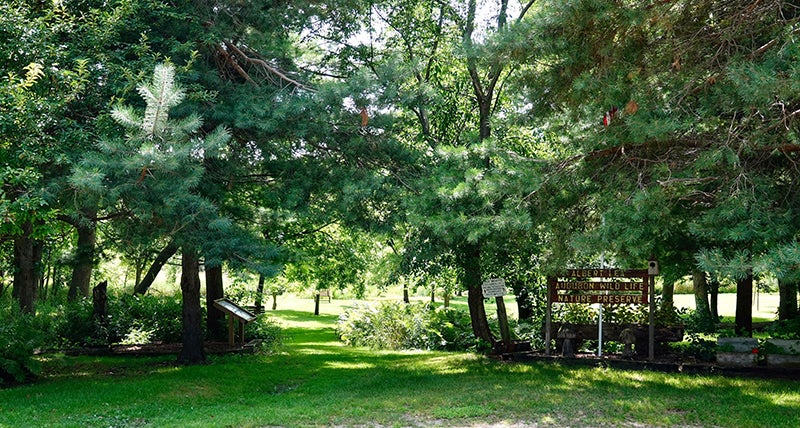Al Batt: One of North America’s largest grasshoppers a common sight now
Published 9:00 am Saturday, August 11, 2018

- Albert Lea Audubon Preserve by Al Batt
Al Batt of Hartland is a member of the Albert Lea Audubon Society. Email him at SnoEowl@aol.com.
My neighbor Crandall stops by.
“How are you doing?” I ask.
“Everything is nearly copacetic. My yard is filled with attack mosquitoes. I try to take down two of them for each one that bites me. Swatting skeeters is Minnesota aerobics. Still Bill gets winded while getting a haircut. He’s a little overweight. It’s probably the result of eating all those raccoon livers when he was a boy. His annual physical includes a parallel parking test. He and Pop play cribbage each day. They play cribbage because Pop isn’t on Facebook. The closest he comes is when he falls asleep face down on one of those mystery novels he likes. Without Facebook to keep up with family members, he is forced to use a police scanner to do that. If you ask Pop how his family is, he replies, ‘Well, no one is in jail.’”
Naturally
The weather had been unseasonably something or another. I knew that because the weather is always unseasonable.
The night had brought sounds with it. Fireflies lit the way for buzzing mosquitoes working the graveyard shift. I enjoyed the sounds of katydids singing, “Katy did. Katy didn’t.” Snowy tree crickets chirped “tree, tree, tree” in a way that the temperature could be estimated. Count the number of songs in 13 seconds and add forty to yield the temperature. It’s “snowy” because of their pale color.
Cicadas sang. In an ancient Greek myth, Tithonus turned into a cicada after being granted immortality, but not eternal youth by Zeus.
It was bird-melting hot. A robin made a small sound of the first bird to see the sun. The only bird singing was an indigo bunting. The mnemonic device used to remember the bunting’s song goes like this: ”Sweet, sweet, chew, chew, see-it, see-it“ or like this: “Fire, fire! Where, where? Here, Here! Put-it-out, put-it-out!”
The neighbors’ lawn bloomed in turkey hens and poults. When poults are about three weeks old, several family groups may merge to form a flock.
Carolina grasshoppers are common now. The Carolina grasshopper, Carolina locust, black-winged grasshopper or road duster is one of North America’s largest grasshoppers and is conspicuous because of its size, colorful wings and habit of flying over dirt roads and other bare ground. The wingspread of the male measures 3 inches and that of the female 3 1/2 to 4 inches.
I happened upon a common milkweed plant that had survived the mowing of a roadside. The plant had a monarch caterpillar on it. One milkweed makes a difference. Honeybees are fond of the fragrant milkweed blossoms and the plants provide a good nectar flow. The bees can become trapped by the sticky pollen masses of the blossoms.
Foxtail barley, sometimes called squirrel-tail grass, gave the roadsides a windswept look. Growing up to 8 feet tall, compass plant, with its large yellow flowers, grew in the ditches. Its leaves have a tendency to orient themselves on a north-south axis, which helps maximize photosynthesis. This helped disoriented settlers find their way.
I found a crab spider. This spider can change its body color to blend with its background. It hunts by ambush without a web.
Dan and Bonnie Ruble of Albert Lea told me of young great horned owls in their yard in June. Young owls move onto nearby branches when they are 6 weeks old. At seven weeks they are capable of short flights. Owlets that appear to have fallen from the nest likely have fledged. Bushes, small trees and stumps provide ladders allowing them to climb to a higher perch until they can fly.
Turkey vultures like to be in areas with a good population of deer because they enjoy road-killed venison.
Dr. Mike Eckstrom of Albert Lea reported a summer tanager that had been eating his honeybees. This red bird is a bee and wasp specialist. It catches bees in flight and kills them by beating them against a branch. Before eating a bee, the tanager rubs it on a branch to remove the stinger.
Albert Lea Audubon Preserve
Friedrich Nietzsche said, “All truly great thoughts are conceived by walking.” Form your great thoughts by taking a walk at the Preserve at the end of Oregon Street in Albert Lea.
The Henderson
Hummingbird Hurrah
This event will be held in beautiful Henderson from 9 a.m. to 4 p.m. Aug. 18. Free fun for the entire family. Birds, bees, butterflies and blooms. Hummingbird banding, speakers, educational booths, children’s activities, garden tours and master gardeners. See you there.
Eagles everywhere in Wabasha until Oct. 14
The Preston Cook Collection at the National Eagle Center offers an extensive look at eagles in history and culture. The collection includes fine art, historical artifacts and cultural ephemera from the 18th century to the present. With over 20,000 items, this collection is the largest of its kind in the world.
Thanks for stopping by
“In our daily lives, we must see that it is not happiness that makes us grateful, but the gratefulness that makes us happy.” —Albert Clarke
“When eating a fruit, think of the person who planted the tree.” —Vietnamese proverb
Do good.

